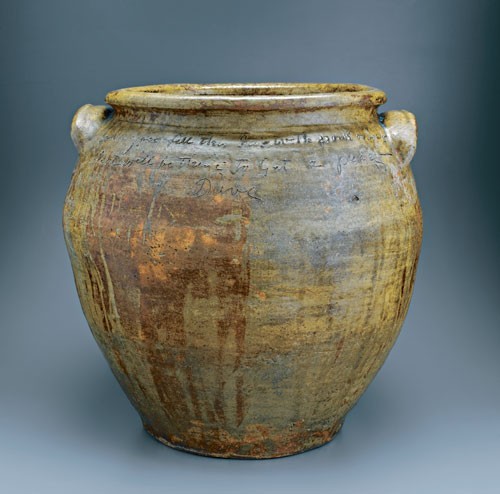
Storage jar, Lewis Miles pottery, 1858. Alkaline-glazed stoneware. H. 25 5/8". Incised in script at shoulder: “This jar is to Mr Segler who keeps the bar in orange burg / for Mr Edwards a Gentleman—who formly kept Mr thos bacons horses / April 21 1858”; on opposite shoulder: “When you fill this jar with pork or beef / Scot will be there to get a peace,— / Dave” and twenty-five short slashes (two rows of ten and one of five). (Courtesy, Arthur Goldberg; unless otherwise noted, all photos by Gavin Ashworth.)

Reverse side of the storage jar illustrated in fig. 1.

Detail of a portion of the poem and Dave’s signature on the shoulder of the storage jar illustrated in fig. 1.
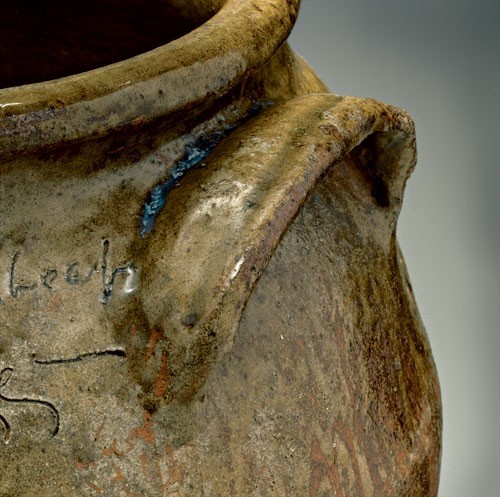
Detail of the rim and one of the large lug handles of the storage jar illustrated in fig. 1. Note blue rutile between the rim and handle.
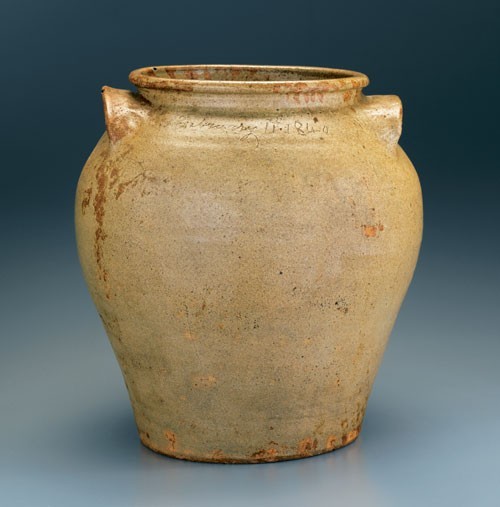
Jar, Lewis Miles pottery, 1840. Alkaline-glazed stoneware. H. 14 1/2". Incised in script at shoulder: “Mr. L. Miles Dave”; on opposite shoulder: “February 11th · 1840” plus two slash marks and five punctates. (Courtesy, Arthur Goldberg).
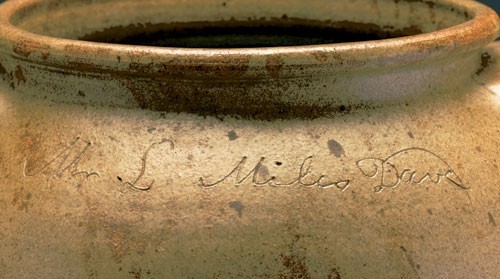
Detail of the inscription and signature on the shoulder of the storage jar illustrated in fig. 5.
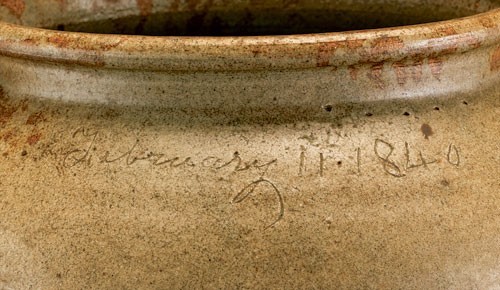
Detail of the incised date on the shoulder and the punctates under the rim of the storage jar illustrated in fig. 5.
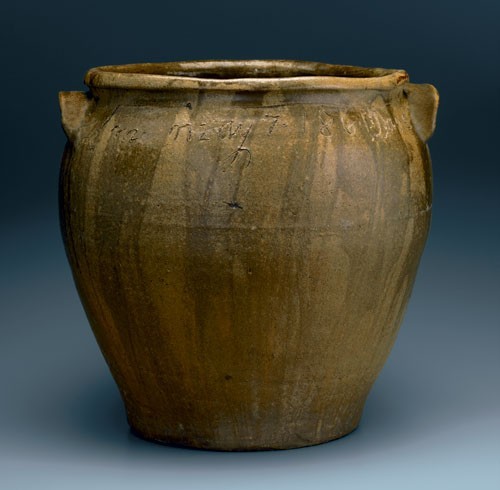
Storage jar, Lewis Miles pottery, 1861. Alkaline-glazed stoneware. H. 17 1/4". Incised in script on shoulder: “Lm May 7. 1861 Dave”; on opposite side: two slash marks. (Courtesy, Arthur Goldberg.)

Reverse side of the storage jar illustrated in fig. 8.

Detail, “A Map of the District of Edgefield,” December 1816, by Thomas Anderson, D.S. (Courtesy, South Carolina Department of Archives and History, Columbia.) This map was later revised and published in the Robert Mills Atlas of the State of South Carolina (1825). The circled areas show the [Abner] Landrum pottery, CH [Edgefield Courthouse], the Rev. Jn. Landrum pottery, and Big Horse Creek.

Detail of the 1870 Federal Census, Population Schedule, South Carolina, showing Dave and Mark Jones and his family in the same household.
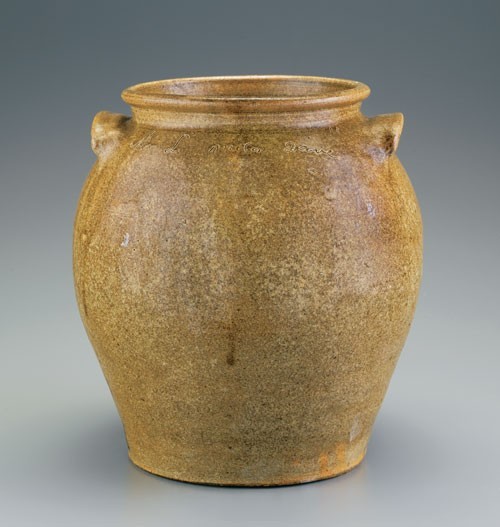
Storage jar, Lewis Miles pottery, 1840. Alkaline-glazed stoneware. H. 13". Incised in script at shoulder: “Mr. L miles Dave" and two slash marks; on opposite shoulder: “20th Nov 1840” and four punctates. (Courtesy, James Witkowski.)
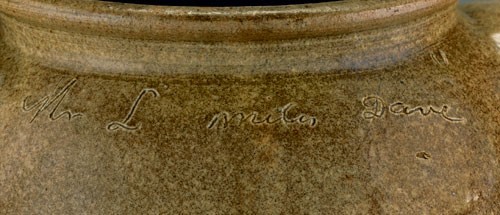
Detail of the inscription and signature, followed by two slash marks, on the shoulder of the storage jar illustrated in fig. 12.

Detail of the four punctates and incised date on the shoulder of the storage jar illustrated in fig. 12.
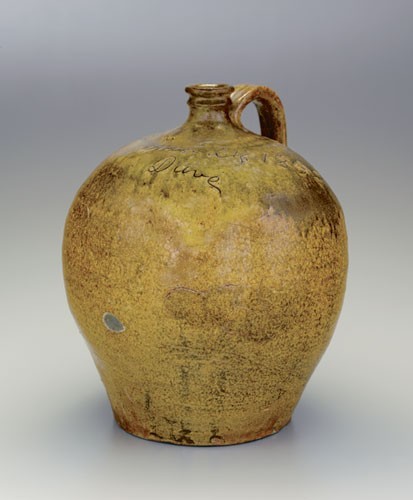
Jug, Lewis Miles pottery, 1858. Alkaline-glazed stoneware. H. 14 1/2". Incised in script: “Lm Feb 24 1858 Dave”; two slash marks and three punctates. (Courtesy, James Witkowski.)
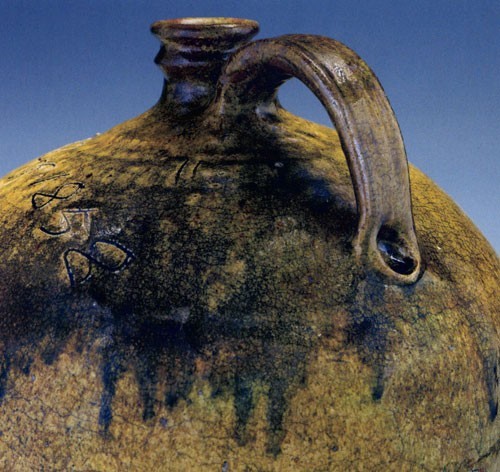
Detail of the handle of the jug illustrated in fig. 15. Note the top of the handle attached at the spout base, the characteristic collar, and the pronounced “thumbprint” at the base of the handle.
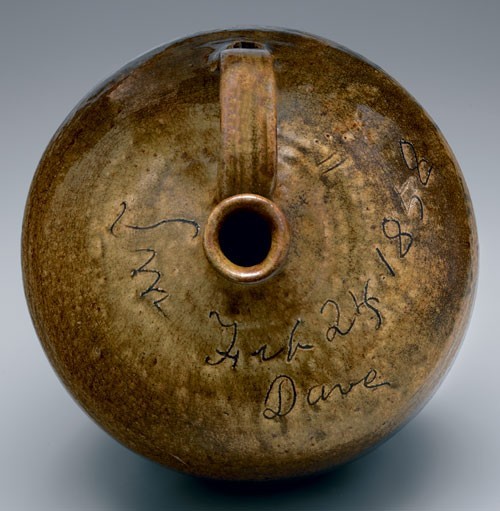
Top view of the jug illustrated in fig. 15.

Storage jar, Lewis Miles pottery, 1857. Alkaline-glazed stoneware. H. 19 1/4". Incised in script on shoulder: “Lm Aug 30 1857 Dave”; on opposite side: two slashes with ten punctates. (Courtesy, James and Mary Smith.) Note the unusual effect produced by pouring additional glaze around the shoulder of the vessel.
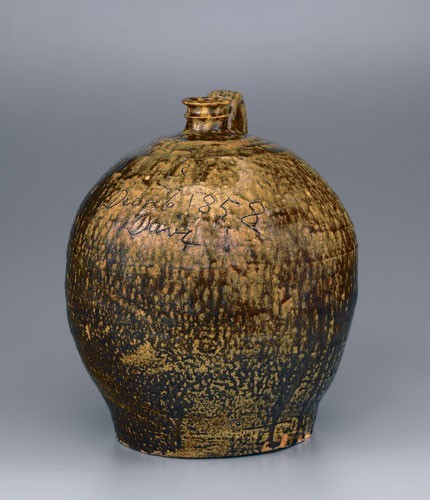
Jug, Lewis Miles pottery, 1858. Alkaline-glazed stoneware. H. 13". Incised in script on shoulder: “Lm Decr 6 1858 Dave.” (Courtesy, Katie Green.)

Storage jar, Lewis Miles pottery, 1858. Alkaline-glazed stoneware. H. 21 1/2". Incised in script on shoulder: “Lm Feb 15 1858” and fourteen punctates. (Courtesy, Lindsay Green.)
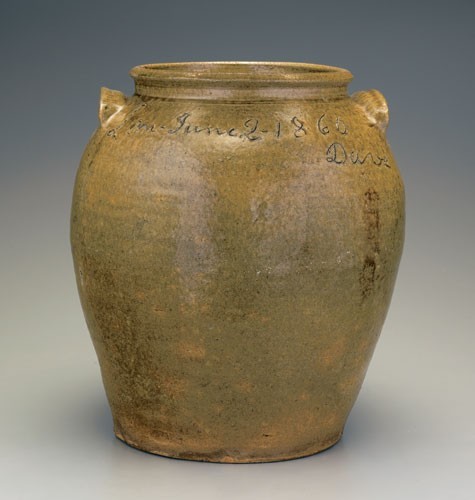
Storage jar, Lewis Miles pottery. Alkaline-glazed stoneware. H. 15 1/2". Incised in script on shoulder: “Lm – June 2 – 1860 Dave”; on opposite side: “X.” (Courtesy, Larry and Joan Carlson.)
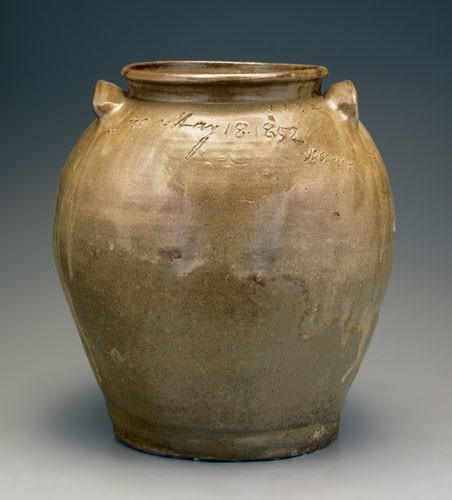
Storage jar, Lewis Miles pottery, 1852. Alkaline-glazed stoneware. H. 17". Incised in script: “Lm May 18 1852 Dave”; on opposite side: backward C and seven punctates. (Courtesy, Larry and Joan Carlson.)
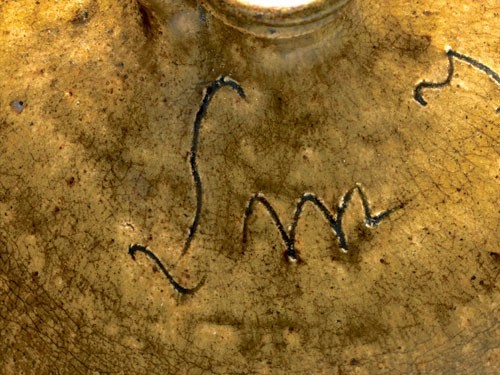
Detail of the inscription on the shoulder of the jug illustrated in fig. 15.
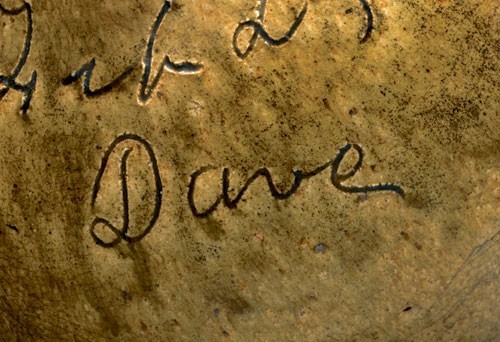
Detail of the inscription on the shoulder of the jug illustrated in fig. 32.
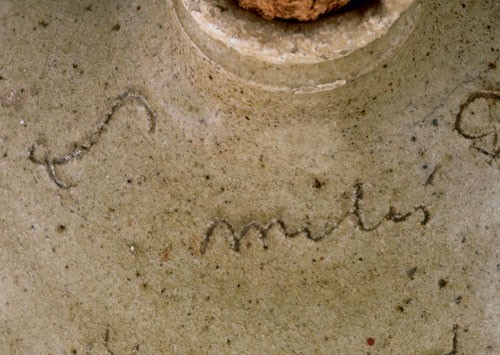
Detail of the signature on the shoulder of the jug illustrated in fig. 15.
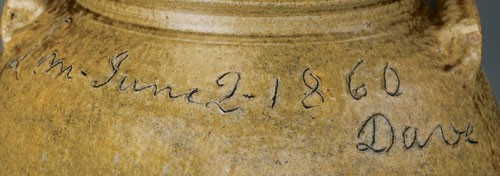
Detail of the inscription, date, and signature on the shoulder of the storage jar illustrated in fig. 21.
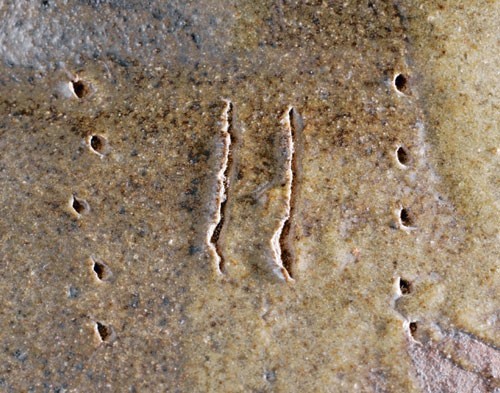
Detail of the two slash marks and ten punctates on the shoulder of the storage jar illustrated in fig. 18.
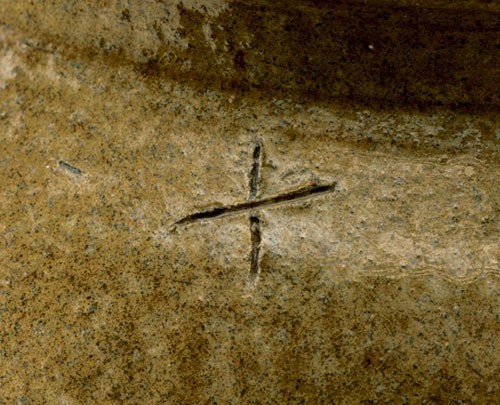
Detail of the X on the shoulder of the reverse side of the storage jar illustrated in fig. 21.
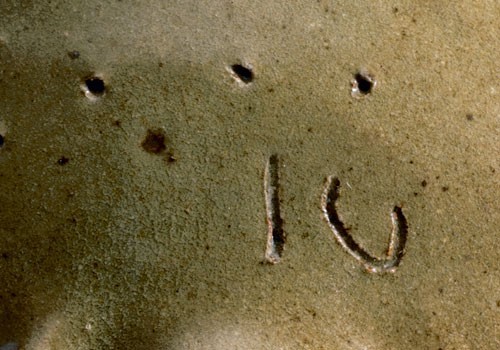
Detail of the four punctates, slash, and U on the shoulder of the jug illustrated in fig. 31

Detail of the backward C and seven punctates on the shoulder of the storage jar illustrated in fig. 22.
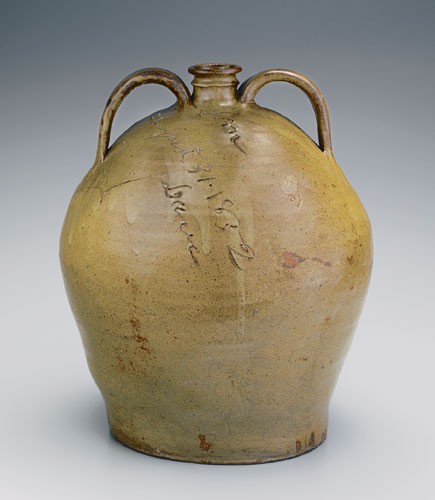
Double-handled jug, Lewis Miles pottery, 1852. Alkaline-glazed stoneware. H. 16". Incised in script: “Lm August 31·1852 / Dave”; on opposite side: slash and U marks with four punctates. (Courtesy, James and Mary Smith.)

Jug, Lewis Miles pottery, 1841. Alkaline-glazed stoneware. H. 14 1/2". Incised in script on the shoulder: “Feby 14th 1841 L miles Dave” and two slash marks. (Courtesy, James and Mary Smith.)
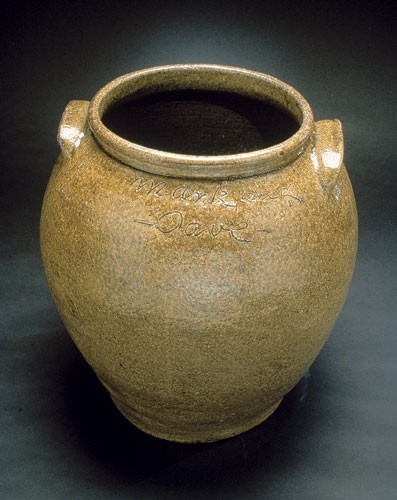
Storage jar, Lewis Miles pottery, 1859. Alkaline-glazed stoneware. H. 15". Incised in script: “Mark and/ –Dave–” and two slash marks; on opposite side: “Lm. March 10·1859.” (Courtesy, Museum of American History, Division of Ceramics and Glass, Smithsonian Institution, Washington, D.C.)

Detail of the signature on the shoulder of the storage jar illustrated in fig. 33.

The authors at the Lewis Miles pottery site at Stoney Bluff
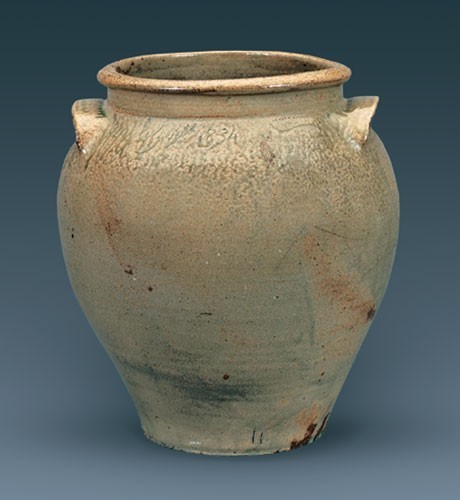
Storage jar, Pottersville pottery, 1834. Alkaline-glazed stoneware. H. 19 1/2". Incised in script at shoulder: “Put every bit all between / surely this jar will hold 14”; on opposite side: “July 12th 1834” and fourteen punctates; at base: two slash marks. (Courtesy, South Carolina State Museum, Columbia.)
Dave, an enslaved African-American potter, made alkaline-glazed stoneware vessels in the nineteenth century in the Edgefield District of South Carolina. His ceramics, especially his large pots, are very expressive and powerful, but his contribution goes beyond the vessels themselves. He is also known for his literacy, at a time when slave literacy was not permitted. It is expressed in the dates, signatures, and poetry incised in script on many of his pots. Dave’s pottery, valued for its functionality when first produced, is now appreciated for its greater value as the historical record of a slave who became an American icon.
This article reviews all of the known dated stoneware vessels that were signed by Dave or are attributed to him. His practice of dating pieces in script to such extent—with month, day, and year—as well as incising poems and inscriptions is unique in the American stoneware tradition and affords an opportunity to analyze his output in a systematic fashion. The most extensive published to date, this listing was compiled by examining pieces in private and public collections, interviewing collectors and curators, and reviewing publications and auction records. A sufficient number of examples exist to allow certain conclusions to be made as to where the objects were produced and the evolution of their forms.
These dated vessels are examined within a coherent chronology of Dave’s life, which includes a review of the potter’s various masters as well as a discussion of the social and political issues in Edgefield at the time. Also included is a general discussion of alkaline-glazed stoneware, which became a uniquely Southern ceramic tradition, and an updated compilation of his poems and inscriptions.
Chronology
The biographical record that follows has been constructed from a review of legal documents, as well as from the written record incised by Dave onto his pots.[1] Dave’s ownership passed between brothers, from father to son, and among in-laws, and indeed, most of his masters are believed to be related. Central figures in his life were two brothers, Dr. Abner Landrum and Reverend John Landrum (the codevelopers of alkaline-glazed stoneware in the South), Harvey Drake, and his last master, Lewis Miles, who permitted a full expression of Dave’s poetic abilities.
Dave was born into slavery in South Carolina about 1800 and was owned by one man, Harvey Drake, until Drake’s death in December 1832. A mortgage agreement dated June 13, 1818, between Harvey Drake, Abner Landrum, and Eldrid Simkins, mentions “two negroes Slaves Dave a boy about 17 years old Country born and Eliza a girl about 18 or 20 years old both my property and my indisputed possession.”[2] An agreement between Amos Landrum (brother of Abner and John) and Eldrid Simkins, dated October 26, 1818, settled the mortgage debt so that Dave would remain in Drake’s possession. It also identifies Harvey Drake, Abner Landrum, and Amos Landrum as “copartners in the business of a pottery establishment in Pottersville,” confirming Harvey Drake’s importance as a figure in the early development of alkaline-glazed stoneware in the Edgefield District and his association with the Pottersville pottery.[3]
The Pottersville pottery, located about a mile from the Edgefield courthouse, was initially established by Abner Landrum about 1815.[4] Dr. Landrum was a physician, businessman, scientific farmer, newspaper editor, and publisher. He displayed his worldly knowledge and enthusiasm for ceramics by naming three of his sons—Wedgwood, Pallisey, and Manisis—after well-known European potters; another son, Linnaeus, conveyed his interest in botany. The Pottersville pottery was very successful, and in his Statistics of South Carolina (1826) Robert Mills credits Abner Landrum with the manufacture of stoneware “which by his discoveries is made stronger, better and cheaper than any European or American ware of the same kind.”[5] In November 1828 Abner Landrum sold his interest in the pottery to Harvey Drake and his brother, Reuben. A partnership agreement between Harvey and Reuben Drake dated July 1, 1830, states: “The following property belongs to Harvey Drake . . . the servants—Dave, Lidy and her children. . . .”[6]
Harvey Drake died in 1832, and the January 31, 1833, estate settlement states that “1 Negro man named Dave [was sold] to Drake and Gibbs for $400.”[7] Reuben Drake and Jasper Gibbs both owned the Pottersville pottery at various times. Drake maintained an interest in the enterprise until September 1836; he moved to Louisiana in 1837. Jasper Gibbs sold his interest in the pottery in October 1839.[8] No dated vessels from the pottery are known to us from 1838.
An article of reminiscences about “Old Pottersville and Dr. Landrum,” published in the Edgefield Advertiser on May 11, 1859, not only confirms Dave’s importance at Pottersville but also sheds light on how he was viewed by adults and children in the Edgefield community:
We cheerfully allow the old ville all the ancient glory claimed for it. Although not quite aged enough to go back distinctly to those stirring days when she was the Cincinnati of Edgefield, we can vividly recall the times when she was the Juggery of South Carolina. The first sight of that furnace nearly thirty years ago,—can we ever forget it? Have we ever been able to think of any other kind of furnace when reading ofShadrack, Meschuck and Abednego? Do we still mind how the boys and girls used to think it a fine Saturday frolic to walk to old Pottersville and survey its manufacturing peculiarities? to watch old Dave as the clay assumed beneath his magic touch the desired shape of jug, or jar, or crock, or pitcher, as the case may be?—No, we are not unmindful of the old times of old Agefield; And we would not have old Pottersville omitted when our history comes to be written out, nor Dr. Landrum, nor the Hive, nor anything good or clever that ever adorned that once prominent locality.[9]
Presumably Dave continued to work in Pottersville until he came under the ownership of Lewis Miles, who, it is thought, owned him from about 1840 to 1843. It is not known how Miles came to own Dave, but Miles’s association with the Landrum family is well documented. Lewis Miles married Dr. Abner Landrum’s daughter; after her death, he married Reverend John Landrum’s daughter, Sarah.[10] A jug dated January 27, 1840, and signed “Dave” and “L. Miles” is the earliest known evidence of their association, and a jar dated July 31, 1840, bears a poem that reads, in part: “. . . Dave belongs to Mr. Miles. . . .” Additional related information comes from the 1840 census, which indicates that Lewis Miles owned one male slave between thirty-six and fifty-five years old (Dave would have been forty years old at that time).[11] A jar signed “Dave” and “Mr. L. Miles,” dated May 16, 1843, is the last known signed and dated vessel until January 27, 1849.
Evidence suggests that from about 1843 to 1847 Dave was owned by Reverend John Landrum, Lewis Miles’s father-in-law, who as early as 1817 had operated a pottery in the Big Horse Creek section of the Edgefield District, about twelve miles south of Pottersville.[12] How Dave came to be owned by Reverend Landrum is not known. The inventory of the reverend’s estate, dated January 22, 1847, lists “1 Boy Dave.”[13] The estate sale, on February 22, 1847, records the sale of a “Man Dave” to Reverend Landrum’s son, Benjamin Franklin (B. F.) Landrum,[14] who operated a pottery in the Horse Creek area, adjacent to Lewis Miles’s plantation at that time. B. F. Landrum owned Dave from about 1847 to 1849.
There are no known vessels signed Dave that date from October 1843 through January 1849, when he undoubtedly worked at both of the Landrum potteries in the Horse Creek area. Archaeological investigations at these pottery sites by Joe and Fred Holcomb in the 1970s yielded sherds with “incised letters, words, decorations, or marks similar to those on Dave’s extant vessels.” There were also sherds similar in form to those on Dave’s double-collared ring necks.[15] In 1994 Carl Steen found sherds at the B. F. Landrum site with characteristics of Dave-made vessels.[16]
From 1849 until he was freed in 1865 Dave was a potter at the Lewis Miles Stoneware Factory at Stoney Bluff Plantation on Big Horse Creek. Miles’s second ownership of Dave, beginning in 1849, is believed to have resulted when Sarah Miles (Reverend John Landrum’s daughter and Lewis Miles’s wife) petitioned for a new executor of her father’s estate, which somehow resulted in Miles’s ownership of Dave.[17] Ending a period of six years with no known marked vessels is a jar dated January 27, 1849, and signed “Lm.” A poem from May 13, 1859, “Made at Stoney Bluff . . . ,” commemorates the pottery. The 1850 census indicates Miles owned a fifty-year-old male slave; the 1860 census shows his ownership of a fifty-six-year-old male slave, presumed to be Dave.[18]
More than one hundred known vessels are dated between 1849 and 1864, and signed “Dave” and “Lm,” and all are believed to have been made at Miles’s Stoney Bluff Plantation pottery. The Census of Manufactures for 1860 provides information on the scale of this operation, with annual production recorded at fifty thousand gallons.[19] Lewis Miles’s personal involvement in the stoneware production, as well as Dave’s dry wit and his ability to tease his owner, is revealed in the inscription on the jug signed by Dave on June 28, 1854: “Lm says this handle will crack.”
Dave’s last known poem, dated May 3, 1862, is charged with political, religious, and social meaning, given the context of slavery and civil war: “I made this Jar all of cross / If you don’t repent, you will be lost.” The last known dated stoneware vessel inscribed “Dave” and “Lm” is dated March 31, 1864.
There is evidence that Dave lost one of his legs in an accident but continued to work as a potter. In interviews conducted by researchers from the Charleston Museum in 1930, an eighty-five-year-old former slave pottery worker, Carey Dickson, recalled:
Of course I knew Dave. I know all about him. He used to belong to old man Drake and it was at that time that he had his leg cut off. They say he got drunk and layed on the railroad track. Later Dave went to Mile’s Mill. After Dave was crippled he had Henry Simkins, who was crippled in the arms, to drive the wheel for him.[20]
Another potter, George Fletcher, also remembered being told “about an old potter there [Lewis Miles’s pottery], a one-legged negro named Dave. He was said to be mighty good.”[21]
Upon obtaining his freedom after the Civil War, Dave changed his name to David Drake, combining a more dignified first name with the surname of his original known owner. The 1870 Federal Census for South Carolina shows a David Drake, age seventy, occupation “turner,” living in the household of Mark Jones, age thirty-five, whose occupation is also listed as “turner.” All of the occupants of this household, including Jones’s five children, are listed as having been born in South Carolina (fig. 11).[22] Notably, a jar dated March 10, 1859 (see figs. 33, 34), is signed “Mark and Dave,” tantalizing evidence that Dave might have passed on his skills as a potter to a future generation. Since the 1880 Federal Census for South Carolina does not list a David Drake in the Edgefield District,[23] it is presumed that he died sometime between 1870 and 1880. After David Drake’s death, Mark Jones and one of his sons worked at another Edgefield District pottery, continuing the stoneware legacy.[24]
Dated Vessels
Table 1 lists the known dated stoneware vessels signed by or attributed to Dave—169 as of this writing. The table, which is organized chronologically, gives basic information about each pot: date, vessel type, overall height, signatures, inscriptions, and other marks. Also included is whether the pot has an incised poem or other type of inscription, and whether it is in a public museum collection.
The vessel types include bulbous storage jars, jars that are more cylindrical (perhaps butter churns), and single- and double-handled jugs. Other vessel forms are attributed to Dave, such as handled pitchers, but there are no known dated examples.
The writing on these pots typically is found on the vessel shoulders, but some of the more elaborate inscriptions extend to the sides. No known examples are marked on the base.[25] At an appropriate time, depending on the degree of drying, the incising was done with a very sharp pointed stylus. As occurs in drypoint etching, when the clay was softer, a burr outlining the writing was produced. This had to be done shortly after the vessel was turned. The size of the letters/numbers varies from about one quarter of an inch to over an inch and a half, and generally increased from the earliest pieces to the later.
On almost all of the vessels listed the dates include month, day, and year. A few vessels have only month and year, a few have the day inscribed before the month, and, in some cases, the month is abbreviated.[26]
The earliest known dated vessel signed “Dave” is a storage jar dated “January 27th, 1840”; the latest is a storage jar dated “March 31, 1864.” Table 1 includes not only vessels signed “Dave” but also pieces that are attributed to him. The attributions are based on the distinctive cursive writing of the dates or other inscribed words, as well as the vessel characteristics (form, handle attachment, and so forth). The attributed pieces, including vessels dating from 1829 to 1836, are believed to have been made by Dave at the Pottersville pottery, where apparently he was not allowed to sign his wares. These attributed pieces include three examples with poems, almost certainly made by Dave (see fig. 36).
Many of the pots made when Dave was producing pottery for Lewis Miles bear inscriptions that acknowledge the relationship between the two men. Typically, the dated vessels have both Dave’s name and “Lm” or some variant of “Miles” inscribed on them. A number have a Lewis Miles inscription but not Dave’s signature, even though they were almost certainly made by Dave and therefore are included in Table 1.
The vessels of the 1829–1839 period are likely examples of Dave’s work while he was at the Pottersville pottery, although they do not bear his signature. Archaeological examples of some of the marks attributed to his work and characteristically impressed at the base of the pot have been found at this site.[27] The pots themselves tend to be slightly more ovoid in shape than the later pieces and vary in height from eleven to nearly twenty inches. The glazes are generally a light yellowish green to olive green color.
The vessels dating from 1840 to 1843, when Dave was owned by Lewis Miles, all bear an inscription including some form of Miles’s name: “L. Miles,” “Mr. L. Miles,” “Mr. Miles,” and “LM.” All of them are signed by Dave with few exceptions—the first known example of the group, dated “January 23, 1840,” is signed “L. Miles” only. One particularly important example, from July 1840, states simply, “Dave belongs to Mr. Miles.” There are five poems known from this period.
Cryptic but somewhat consistent markings appear on the shoulder of many of the pieces in this group: two parallel slash marks and a U (or reversed C), sometimes referred to as a horseshoe mark. Often they appear next to punctates, which seem to indicate vessel size in gallons (see figs. 27, 29, 30).
The size of the vessels in this group is generally comparable to that of the earlier examples, although one jar made in 1843 is over twenty-seven inches tall. The glazes, usually a light olive color, vary somewhat and are discussed in more detail in a later section of this article.
The lack of dated vessels from 1844 through 1848 (see Table 2) seems to indicate that Dave’s owners—believed to have been Reverend John Landrum and, subsequently, his son, B. F. Landrum—did not allow Dave to sign and date his pots. Although no dated or signed vessels from this period have come to light, Dave undoubtedly was turning pots at the Landrum potteries on Horse Creek, and sherds found at those two sites support this conclusion.[28]
The majority of Dave’s signed and dated vessels, more than one hundred, are from the years 1849 through 1864. During this period Dave started to abbreviate Lewis Miles’s name as “Lm” and he used these initials exclusively from 1850 on (see fig. 23). In addition to the capacity punctates and the double slash and horseshoe markings noted earlier, an X mark (see fig. 28) and three slashes are used.
As shown in Table 2, the number of surviving pieces indicates that Dave’s output peaked about 1857–1859, when he was approaching the age of sixty, and confirms that the Lewis Miles pottery was a large-scale, year-round operation.[29] Dave’s poetic expression was also most prolific in this period, with at least eighteen poems. A storage jar signed “Dave” and “Lm” and dated May 13, 1859, has the incised couplet “Made at Stoney Bluff / for making lard enuff,” confirming the location of the pottery at Stoney Bluff, Lewis Miles’s plantation on Horse Creek (fig. 35).
The vessels produced by Dave in this period include some very large storage jars, a number over twenty-four inches in height and with capacities well over twenty gallons. The large jar shown in figures 1 and 2 was made with about five large joined coils, with its rim probably separately turned. Dave’s skill at turning and coiling such large pots may have been unique in the Edgefield District, making his products much in demand as plantation utilitarian wares.
The glazes used during this period vary greatly, and their lack of uniformity might indicate experimentation with glaze materials and techniques. Many are a darker green than the earlier pieces, and some pots have a distinctive dark brown glaze. A few examples show evidence of a secondary glaze applied to the shoulder of the vessel, probably for decorative effect (see figs. 18, 22).
The dates inscribed on many of Dave’s pots make it possible to determine the day of the week the vessel was produced. As shown in Table 3, Dave turned pots seven days a week. However, significantly fewer dated vessels were produced on Sundays compared to the other days of the week, a trend that holds regardless of the time period examined. This is intriguing evidence that Dave’s masters might have allowed other activities or a period of rest on the Christian Sabbath.
For all of the unsigned vessels clearly attributable to Dave that bear an inscribed “Lm” and/or other marks, in general only one per day appears to have been dated.[30] Was this a practice for marking the start or end of a day’s work? By the same token, we have not encountered any vessels signed by Dave that are not dated.
Characteristics of Dave’s Wares
Dave made a number of changes in the pots he created over the course of nearly fifty years—most notably being the large vessels he produced in the 1850s and the different glazes—but some characteristics remained the same.
His storage jars are very substantial, typically having quite broad bases and thick walls, consistent with their function. Regardless of their size, they are described by potters today as “powerful,” “strong,” and with “great presence.” Most have a rolled rim that could be used to tie down material covering the opening. The handles are usually “lug type” and are located quite close to the rim (see fig. 4). Some of the larger storage jars have four lug handles, most have two. There is only one known example of a storage jar with “strap” handles.[31]
Dave made both single- and double-handled jugs—the latter used for larger forms—with spouts that have “double-ringed” collars. The strap handles are usually attached quite close to the base of the spout, and many have a pronounced thumb indentation at the lower point of attachment, all characteristics that can be seen on the jug illustrated in figure 16.
Alkaline Glazes
Two of the earliest potteries in the Edgefield District are believed to have been Pottersville, owned and operated by Dr. Abner Landrum, and that owned by Reverend John Landrum on Horse Creek, both identified on the Anderson Edgefield District survey map of 1816 (see fig. 10). These men are credited with being codevelopers of the use of alkaline-glazed stoneware in Edgefield, a tradition that spread to North Carolina and the southernmost states and, eventually, westward.[32] John Burrison explains:
Alkaline glazes are so called by researchers because they contain an alkaline (high pH or caustic base) substance—in the case of stoneware from the Deep South, wood ashes or slaked lime—as a flux or melter to reduce the maturation temperature of the glaze so that it matches that of the clay body. The wood ashes (pine from the kiln firebox or hardwood from the home fireplace) produce lye (sodium or potassium hydroxide) when mixed with water in the glaze solution. Some potters obtained lime from nearby lime-kiln operations or by burning limestone in the pottery kilns, then added water to the resultant white powder to create slaked lime (calcium hydroxide); others purchased commercial builders’ lime. Variation in alkaline glaze color is largely attributable to three factors: the degree of iron present in the clay body, the amount of iron in the glaze, and the kiln atmosphere. Variation in alkaline glaze color is largely attributable to three factors: the degree of iron present in the clay body, the amount of iron in the glaze, and the kiln atmosphere.[33]
Some of the complexities of the glazing results have been discussed by ceramic scholars Charles Zug and Georgeanna H. Greer.[34] The variegated colors and their distribution on the vessels were endless. When significant reduction (reduced oxygen) occurred during the firing process, blue crystal titanium, called rutile, could form in the glaze (see fig. 4).[35]
Using local iron-bearing clays with significant kaolin content, the potters were able to produce high-fired vitrified stoneware (2200° F, 1300° C) that was impervious to liquids. In addition to the initial glaze, ashes (fly-ash) developing during the wood firing would be deposited in varying amounts on the upper portions of the vessels, melting in an unpredictable fashion onto the vessels to fuse with the glaze, particularly on the shoulders of the pieces (see figs. 16, 36). “At these temperatures the silica in the clay [or sand] will meet and fuse naturally when fluxes such as lime, soda or potash, which are naturally present in wood ashes, are added. The materials meet and harden. . . .”[36] This results in a glass surface. It is during this period that the stoneware itself matures and is vitrified.
The use of alkaline glaze and its firing techniques was one of the great contributions to American ceramics, and without apparent European antecedents. In fact, this glazing technique had its origin hundreds or perhaps thousands of years ago, in China, Japan, and Korea. So how did this rediscovery take place in such a small and relatively isolated rural community?
The answer is unclear. Perhaps the rediscovery of the use of wood ash and lime constituents of the glazes was developed from considerable experimentation or was simply fortuitous, or perhaps the Landrums had read firsthand accounts from published eighteenth-century letters from missionaries in China.[37] Unfortunately, whereas American art museums proudly exhibit Chinese, Korean, and Japanese ash-glazed stoneware, it is rare for a major art museum in the United States to display similarly glazed Southern stoneware. These vessels are certainly of equivalent beauty, however, and deserve respect and recognition.
Glazes on Dave Vessels
The glazing and firing techniques varied at the different potteries where Dave worked during his lifetime, producing richly varied surface colors. When examining the glazes on his vessels, examples of all the various glazes described can be seen. The exact glazing formulas and kiln firing methods used at the potteries where he worked are not known.
It is also difficult to pinpoint when a specific vessel was made by the glaze itself, because there is such a wide range of colors and textures of alkaline-glazed stoneware. In addition to the specific glazes used, one must take into consideration the different clays and their interaction with the glazes, firing conditions (oxidation/reduction ratios, temperature, and so forth), and where the vessel was placed in the kiln. All affected glaze colors and textures as well as the fly-ash fallout. Only broad generalizations can be made about the widely varied glazes and textures on Dave’s vessels.
The earliest vessel glazes of the 1830s and 1840s are typically in pleasingly warm earth tones—yellowish, green, olive, gray, tan, or brown with transitional hues. By the 1850s and through the 1860s the brown to dark brown to almost black glazes seem to have been preferred. Nevertheless, some vessels with light tan glazes and others with variations of dark olive-green to brown hues were also made (see figs. 21, 31). Rarely one finds a white drippy glaze running over the shoulder and body, as in figure 22, or patches of reddish brown.
The tactile and visual surface characteristics vary from shiny, smooth, and glossy to rough. These textural changes occurred with a thin or thick application of the glaze distributed evenly or irregularly on the vessel. We have not seen a translucent celadon-type green to bluish green glossy glaze or slip decoration on any of Dave’s signed or dated vessels as seen on the wares of other Edgefield potters.[38]
In addition to the glaze colors, there are other surface additions. One of the most distinctive are fly-ash deposits, resulting from the wood-fired kiln, producing variegated colors over the shoulder. The fly-ash visually reflects the firing process, since it outlines the form above the waist of the vessel. At times there were glaze splashes, runny streaks, and drips. Occasionally patches of iridescent and luminous rutile blue (titanium oxide) can be seen, as shown in figure 4. All these unpredictable decorative effects produced a glorious array of colors, frequently melting into each other.
Literacy and Freedom of Expression
A review of the general social and political circumstances of the period and region in which Dave lived and worked serves to underscore his talent, creativity, and popularity.
The hardship, danger, and lack of dignity suffered by slaves in America, especially those in the South, are well documented. “Literate or illiterate, skilled or unskilled, African Americans lived with oppression from whites. Edgefield slaves endured savage cruelty, family separation, and sexual abuse from their masters. . . . Violence and the threat of physical punishment underlay all other devices and strategies for the control of slaves. Whites had absolute authority to whip slaves, whether adult or child. Slave parents had to stand aside if whites wanted to whip children. Slave children had to watch while whites humiliated and whipped fathers and mothers.”[39]
Another form of control was exerted through a policy of maintaining illiteracy among slaves. Most Southern states in the 1830s had legislation prohibiting their education, and “of all of the Southern states which restricted black literacy, South Carolina [which had no public school system prior to the Civil War] passed the harshest law against teaching slaves and even free blacks to read and write.”[40]
The complex relationships between slaves, their masters, religious leaders, and the general population were complicated by the diversity of opinion regarding the continued oppression of slaves, Christian moral teaching, and emancipation.[41] Four states—Georgia, North Carolina, South Carolina, and Virginia—banned the teaching of slaves and free blacks until 1865, yet those laws were seldom enforced.[42] In fact, quite a few slaves learned to read, for a variety of reasons: those with religious masters wanted them to be able to read the Bible; slave children absorbed the teachings of white children; literate slaves shared their knowledge with others; and, in some situations, literacy was necessary in order for slaves to perform their jobs.[43]
When or how Dave learned to read and write is not known, although it is likely he learned at a fairly young age. He certainly had the intelligence and ability, and by the time South Carolina’s stringent anti-literacy law of 1834 was passed, he was an adult and already literate, as we know from the poems written on his (unsigned) jars at this time—one from 1834 and two from 1836.[44]
An editorial published in the Edgefield Advertiser on April 1, 1863, reads, in part:
One day in years gone by we happened to meet DAVE POTTERY (whom many readers will remember as the grandiloquent old darkey once connected with a paper known as the Edgefield Hive) in the outskirts of his beloved hamlet. Observing an intelligent twinkle in his eye, we accosted him in one of his own set speeches: “Well, uncle DAVE, how does your corporosity seem to sagatiate”—“First rate, young master, from top to toe—I just had a magnanimous bowl-full of dat delicious old beverage, buttermilk.” Who has not often felt his buttermilk as DAVE did.[45]
How Dave was “connected” to the Hive is not known. Many authors presume that he was a typesetter there, but offer little if any supporting evidence. Whatever the connection, the paper would have afforded Dave a significant learning opportunity. He was, as the quotation implies, treated with respect, and his grandiloquence and humor were clearly appreciated.
Dr. Abner Landrum could have played a role in teaching Dave to read and write. As a unionist—and at odds with his community in that regard—Landrum opposed anti-literacy legislation and “protected and fostered the freedom to read, write and worship for slaves and free blacks. . . .”[46] He was one of the owners of the Edgefield Hive from 1830 to 1831, when he departed to become editor of the state capital newspaper, renamed the Columbia Free Press and Hive, where his views would be more easily tolerated. This paper, the principal publication of the Republican party, was described as “the organ of the Union cause.”[47] Landrum died on April 3, 1859.[48]
Dave’s early potting experience at Pottersville was in close association with Dr. Abner Landrum, the Drake brothers, and Jasper Gibbs. Any of Dave’s masters could have tutored him. Significantly, during this period they permitted him to write poems and words on his vessels but his name does not appear on the pots. After 1837, however, the special personal and working relationships Dave had with his masters—plus the respect of the members of his community—were such that they chose to disregard the terms of the 1834 South Carolina Slavery and Freed Persons of Color Law, knowing they could be fined and Dave could be whipped. There are even anecdotal reports of amputations of the hand or parts of digits occurring in some Southern states if a slave was known to have learned to read or write.[49]
Given Dave’s relative freedom to express himself on his pots, what could account for the gap of five years, between 1843 through 1848, when he produced no poems or inscriptions? In that period he was owned by Reverend Landrum and his son B. F. Landrum, both of whom must have known about the poems Dave wrote while at Lewis Miles’s pottery. Did the political climate in Edgefield change, or were the Landrums opposed to allowing a literate slave to express himself—or even incise his name—on their vessels? Based on the evidence we can only speculate.
Little is known about the political, social, or religious views of Reverend John Landrum and his son, B. F. The reverend served as minister of Horne’s Creek Baptist Church—of which his son was also a member—and he was said to “correct the morals and mind the heart of his fellow men.”[50] He once “expelled his brother Amos from his church in January 1839 for drunkedness after he had been duly admonished,”[51] an act that gives us insight into the reverend’s rigid and perhaps unforgiving personality. At the very least, it would take a person capable of complex rationalizations to be both slave owner and a proper minister.
Reverend Landrum died on December 9, 1846. Excerpts from his laudatory obituary state that he “entered upon his ministerial functions about 1790, and was a zealous and untiring preacher of the gospel for more than fifty years.” He was touted for his “simplicity of manners, purity of character, and devotion to religion,” as well as for a mind that was “never occupied with amusements, or with anything in its nature, trifling.” Reverend Landrum “was a warm friend to education and left no proper opportunity to embrace its advantages to society.” The author further described him as “constant in friendship; a kind husband, an affectionate parent and a good citizen.” There was no reference to the reverend’s stoneware pottery.[52]
After Reverend Landrum’s death, B. F. Landrum and Lewis Miles reportedly cooperated in the management of his pottery but had a “falling out”; by 1850 both are listed as having separate establishments.[53]
There is evidence that B. F. Landrum was authoritarian, like his father, and a harsh slave owner. At the pottery he reputedly whipped and bound a female slave “of turbulent disposition” who had threatened to run away. Shortly after the beating, she hung herself.[54]
In contrast, Dave’s relationship to the reverend’s brother, Dr. Abner Landrum, appears to have been respectful and affectionate. Five days after the notice of Dr. Landrum’s death appeared in the Edgefield Advertiser Dave made a jar, dated April 14, 1859, bearing the dedication:
Over noble Dr. Landrum’s head
May guardian angels visit his bed[55]
Starting in January 1849 Dave was again owned by Lewis Miles and apparently was allowed to do what he had done previously, for there resulted an incredible proliferation of marked vessels. As before, all of the writing was in script, although now only Miles’s initials—“Lm”—not his full name, were incised.
From August 1857 through July 1859 eighteen Dave poems are known. Three additional vessels with poems were made between 1860 and 1863, all with Dave’s signature. Judging from this volume, it seems certain that Miles supported, even fostered, Dave in his activities. It is intriguing that the provisions of the 1834 law were disregarded by Miles (and, indeed, by Dave himself), that despite monetary incentives it seems no one came forward to inform the local authorities of the breach, and, if anyone had, no action was taken by the local government.
What sort of man was Lewis Miles? Little is known of his personal life. A former Edgefield turner once stated that Miles was known for his charity: “If you gave a dollar he’d give a hundred.”[56] Despite being his owner, Lewis Miles allowed Dave to inscribe his poems and to sign his works. Considering the laws and social climate of the time, Miles had the strength of character to risk criticism and even punishment. Were it not for him, the extent of Dave’s contributions would have remained largely unknown.[57]
An underlying question that must be asked, then, is why did Miles not free Dave? The answer lies in the laws in South Carolina at the time, which prohibited manumission. Even after 1840 it was all but impossible. Emancipation could be achieved only by appealing to the state legislature, which invariably rejected all claims. The slave system did not allow for any other legal methods by which to obtain, or grant, freedom.[58]
Dave’s Poems and Inscriptions
A chronological listing of Dave poems and inscriptions, updating the previous compilation of poems prepared by Jill B. Koverman,[59] is provided in Table 4. It includes thirty poems, nine inscriptions, and one dedication. It is beyond the scope of this paper to give an extensive interpretation of Dave’s poems, although those directly related to his masters as well as some provocative words have been discussed.[60]
One can only imagine what Dave’s signature and writings meant to him. His literacy in his slave community was a sign of intelligence and some measure of independence. With each succeeding year, Dave gained status and confidence and, with that, his signatures became larger. Every word he wrote and every pot he signed not only represented his own, nonviolent resistance to slavery but also reflected the ambivalence of at least some of his masters to the laws of oppression.
Moreover, with his writings Dave was able to communicate directly with both the slave and white communities. Seeing these vessels surely inspired slaves to become literate and to seek their freedom. Each incised vessel was not an isolated work, because its importance went far beyond.
The full influence of Dave’s writings on the white and slave communities of his time is yet to be fully recognized and understood, but his importance is undeniable. He was an innovator in the Southern stoneware tradition, combining the art of his pottery with that of his incised poems—and doing so as a slave who not only could read and write but who used those skills to express himself during one of the most oppressive and dangerous periods in American history.
When admiring a Dave pot today, the impulse arises to communicate with it. For many it awakens an intangible spiritual feeling. We want the tactile pleasure of holding it, to grasp it with both hands, to feel its girth and weight, and to rub our hands gently across the vessel, appreciating its texture while admiring its many colors and hues. When the burned and underfired areas, touch marks, and glaze interactions are observed, we reflect on the potting process and the firing, with images of fire and smoke billowing from the kiln chimney. This also brings to mind the historical background and culture of the period. And from this we understand why Dave’s utilitarian pots—made for the everyday needs of the households and plantations of rural South Carolina—have been transformed into objects of beauty and art.
ACKNOWLEDGMENTS
The authors are most grateful for the cooperation and assistance of numerous collectors, librarians, and museum curators who shared their information about the dated vessels and history of the period. This paper would not have been possible without the previous research done by the scholars who recognized the significance and importance of Dave and the Southern alkaline-glaze tradition. We also thank Susan Witkowski, Michael Schoenwald, and Deborah A. Goldberg, Ph.D., for their assistance in preparing this paper.
Jill Beute Koverman, “Searching for Messages in Clay: What Do We Really Know about the Poetic Potter, Dave?” in I made this jar . . . : The Life and Works of the Enslaved African- American Potter, Dave, edited by Jill Beute Koverman, exh. cat. (Columbia: McKissick Museum, University of South Carolina, 1998), pp. 22–25.
Ibid., p. 23 n. 10
Ibid., p. 23 n. 12.
“A Map of the District of Edgefield, made in conformity to the Resolutions of the Legislature in December 1816, by Thomas Anderson, Dep. Surveyor,” South Carolina Department of Archives and History, mb5-6. The original manuscript of this map shows “Landrum’s Pottery” approximately one mile northeast of the Edgefield courthouse. When the map was published in 1817 the notation was changed to indicate a “Pottery” at “Landrumsville.” This map also shows Reverend John Landrum’s pottery.
The comment is believed to be a reference to alkaline-glazed stoneware. Robert Mills, Statistics of South Carolina (Charleston, S.C.: Hurlbut and Lloyd, 1826), pp. 523–24. Mills further describes the site: “There is another village of sixteen or seventeen houses, and as many families, within a mile and a half of Edgefield court-house, called the Pottery, or Pottersville, but which should be called Landrumville, from its ingenious and scientific founder, Dr. Abner Landrum.”
Koverman, “Searching for Messages in Clay,” p. 23 n. 10.
Ibid., p. 23 n. 14.
Joe L. Holcomb and Fred E. Holcomb, “South Carolina Potters and Their Wares: The Landrums of Pottersville,” South Carolina Antiquities 18, nos. 1–2 (1986): 53.
“Old Pottersville and Dr. Landrum,” Edgefield Advertiser, May 11, 1859; South Carolina Library, Columbia, South Carolina.
Koverman, “Searching for Messages in Clay,” p. 24 n. 16.
1840 Federal Census, Edgefield County, p. 83; South Carolina Department of Archives and History, Columbia, South Carolina.
Thomas Anderson’s 1816 map of Edgefield District (South Carolina Department of Archives and History, mb 5-6) shows “Rev. Jn. Landrum’s Pottery” located approximately twelve miles southwest of the Edgefield courthouse, on Big Horse Creek.
Edgefield County Probate Records, Box 56, Package 2312, South Carolina Department of Archives and History, Microfilm Roll ED32.
Ibid.
Joe L. Holcomb and Fred E. Holcomb, “Archaeological Findings Related to Dave at Edgefield Pottery Sites,” in I made this jar . . . , pp. 73–81.
Carl Steen, “An Archeological Survey of Production Sites in the Old Edgefield District of South Carolina,” unpublished report, Diachronic Research Foundation, Columbia, S.C., December 1994, p. 81.
Koverman, “Searching for Messages in Clay,” p. 24.
Ibid.
Joe L. Holcomb and Fred E. Holcomb, “South Carolina Potters and Their Wares: The History of Pottery Manufacture in Edgefield District’s Big Horse Creek Section, Part I (ca. 1810–1925),” South Carolina Antiquities 21, nos. 1–2 (1989): 26.
“Notes made on trip to Seigler’s Pottery, near Eureka, S.C., October 4, 1930,” Charleston Museum Archives, Edgefield Pottery file, Charleston, S.C. The Seigler Pottery, located near Lewis Miles’s Stoney Bluff pottery site, was active from about 1875 to 1898.
The date of Dave’s alleged train accident is not known. It could not have happened in the Edgefield village area if it occurred while Dave was working for Drake (1828–1832) because the South Carolina Railroad, starting in Charleston, did not begin service until about 1833, and it bypassed Edgefield when it extended its line to Hamburg (North Augusta). See Cinda K. Baldwin, Great and Noble Jar: Traditional Stoneware of South Carolina (Athens: The University of Georgia Press, 1993), p. 46. Perhaps the incident occurred later, or while Dave was working for Lewis Miles, since the Charleston-Augusta railroad passed within a few miles of Miles’s pottery (see Isaac Boler, “Map of Edgefield County, S.C.,” 1871, obtained from the Old Edgefield District Genealogical Society). To date, however, no report of his accident has been found in the local newspaper, which probably would have mentioned it.
Fletcher continued:
Old Dave used to sit around the place dozing and one day a goat came up and when Dave’s head would drop over and jerk back the goat thought Dave was bantering him and that goat just backed off and rammed him, knocking him off his seat. Dave always said that somebody hit him with a plank, and never would believe that a goat did it.
“Notes collected on trip to various potteries. Miss L.M.B. & E.B.C. June 24–26 1930,” Charleston Museum Archives, Edgefield Pottery file, Charleston, S.C. “Miss L.M.B.” is Laura M. Bragg, director of the Charleston Museum at that time.
1870 Federal Census, Population Schedule, South Carolina, Edgefield County, National Archives m593-1495, p. 433. The other listed members of the household were: Caroline, age 28 (presumed to be Mark’s wife); Brister, 10; Pierce, 8; Emma, 6; David, 4; and an infant, 1 month. It is not known whether any of these individuals were related to Dave.
There are two original handwritten versions of this census; one was made for the federal government, the other for the state of South Carolina. On the federal copy, the occupations of both David Drake and Mark Jones appear to be written as “Turner,” although the “u” in David Drake’s occupation seems to have been altered to form an “a.” This is not clarified by the state copy, where overwriting on David Drake’s occupation results in an unintelligible word and Mark Jones’s occupation is clearly but inaccurately written as “Farmer.” The census also has a column which indicates that they could neither read nor write, which is in error because we know that Dave could do both. Census of Shaw’s Creek Township, Edgefield County, July 11, 1870; South Carolina Department of Archives and History.
1880 Federal Census, Population Schedule, South Carolina, Edgefield County, Shaw’s Creek Township, t9-1228.
Howard A. Smith, Index of Southern Potters (Mayoden, N.C.: Old America Company, 1986), pp. 84, 161. Two black potters, Mark and Brewster Jones, are listed later on as working at the Seigler Pottery, located thirteen miles from Edgefield. Brewster is perhaps Mark Jones’s son, listed in the 1870 Federal Census as Brister. See also “Notes made on trip to Seigler’s Pottery,” Charleston Museum Archives.
Printed in capital letters on the base of a jug dated September 6, 1859: “DADY.GIBS / MAUM HANNAH / STEPNENS / BY TIM.” The significance of this inscription is unknown. This jug is in a private collection.
Three vessels signed by or attributed to Dave on which are inscribed only the month and year are known: January 1850 (signed “Lm”); June 1855 (signed “Lm”); and October 1855 (signed “Dave” and “Lm”).
Holcomb and Holcomb, “South Carolina Potters and Their Wares,” pp. 52, 57.
Holcomb and Holcomb, “Archaeological Findings Related to Dave at Edgefield Pottery Sites,” pp. 76–79.
Holcomb and Holcomb, “South Carolina Potters and Their Wares,” p. 26.
The only known exceptions are two vessels—a jug and a jar with a poem—both dated December 6, 1858, and two jars with poems signed by Dave and Baddler (another Edgefield slave) and dated May 13, 1859.
A storage jar signed “Dave / Lm” and dated March 31, 1858, has two horizontal loop handles, as opposed to the lug handles typically found on Dave storage jars.
Holcomb and Holcomb, “South Carolina Potters and Their Wares,” p. 12. See also note 5 above.
John A. Burrison, “Alkaline Glaze Stoneware: A Deep South Pottery Tradition,” Southern Folklore Quarterly 39, no. 4 (December 1975): 382.
As Charles Zug explains: “[P]erhaps the simplest form of the alkaline glaze was a mixture of equal parts of clay and wood ashes. The former provided the necessary silica and alumina, while the latter provided additional silica and alumina as well as calcium, sodium, and potassium oxides—the alkaline substances that serve to flux the compound. Pine ash, for example, contains, 24.39 percent silica, 9.71 percent alumina, 39.73 percent lime, 3.77 percent sodium oxide, 8.98 percent potash, and additional oxides of iron, manganese, magnesium, and phosphorous. As this analysis reveals, lime is the principal flux.” Charles G. Zug III, Turners and Burners: The Folk Potters of North Carolina (Chapel Hill: University of North Carolina Press, 1986), p. 179.
In “Alkaline Glazes and Groundhog Kilns: Southern Pottery Traditions,” Antiques (April 1977): 768, Georgeanna H. Greer describes how green hues were achieved:
The green hues of the glaze were determined primarily by the amount of iron present in the glaze solution and the conditions under which it was fired. In a clear-burning firing 1 to 3 percent iron will produce a creamy tan to straw color, while 5 percent or more will produce brown to black colors. The more common smoky or reducing firings, which chemically rob the iron compounds of oxygen, produce colors in the green range, from a pale blue-green through grassy and olive colors to deep blackish green, again depending upon the amount of iron in the glaze mixture. Streaks of pale sky blue mixed with white and blotches of deep blood red which appear on some of the pottery are also produced by iron under special conditions.
Daisy Wade Bridges, Ash Glaze Traditions in Ancient China and the American South (Robbins, N.C.: Southern Folk Pottery Collectors Society, 1997), p. 17.
Ibid., pp. 13, 14.
For an extensive review of the history and diVerent possibilities, see Baldwin, Great and Noble Jar, pp. 18, 19. See also Bridges, Ash Glaze Traditions, pp. 5–10; Burrison, “Alkaline Glaze Stoneware,” pp. 386–88; Zug, Turners and Burners, pp. 70–74.
Dave’s contemporaries in Edgefield—Thomas Chandler, for example—produced wares with a celadon glaze.
Orville Vernon Burton, In My Father’s House Are Many Mansions: Family and Community in Edgefield, South Carolina (Chapel Hill: University of North Carolina Press, 1985), p. 46. This is an excellent, comprehensive study of the social, political, economic, religious, and cultural conditions of whites and slaves in Edgefield, South Carolina, during this period.
Janet Duitsman Cornelius, “When I Can Read My Title Clear,” in Literacy, Slavery, and Religion in the Antebellum South (Columbia: University of South Carolina Press, 1991), p. 37. Anti-literacy laws existed in South Carolina as early as 1740, when the state was under British rule:
XLV And whereas, the having of slaves taught to write, or suffering them to be employed in writing, may be attended with great inconveniences; Be it therefore enacted by the authority aforesaid, That all and every person and persons whatsoever, who shall hereafter teach, or cause any slave or slaves to be taught, to write, or shall use or employ any slave as a scribe in any manner or writing whatsoever, hereafter taught to write, every such person and persons, shall, for every such offence, forfeit the sum of one hundred pounds current money.
The 1834 act, legislated nearly one hundred years later, was far more punishing, however, and added corporal punishment for the slaves themselves:
No. 2639. AN ACT to amend the Laws in relation to Slaves and Free Persons of Color
Be it enacted, by the honorable the Senate and House of Representatives, now met and sitting in General Assembly, and by the authority of the same, If any person shall hereafter teach any slave to read or write, or shall aid or assist in teaching any slave to read or write, such person, if a free white person, upon conviction thereof, shall, for each and every offence against this Act, be fined not exceeding one hundred dollars, and imprisoned not more than six months; or if a free person of color, shall be whipped, not exceeding fifty lashes, and fined not exceeding fifty dollars, at the discretion of the court of magistrates and freeholders before which such free person of color is tried; and if a slave, to be whipped at the discretion of the court, not exceeding fifty lashes; to informer to be entitled to one half of the fine, and to be a competent witness. And if any free person of color or slave shall keep any school, or other place of instruction, for teaching any slave or free person of color to read or write, such free person of color or slave shall be liable to the same fine, imprisonment and corporal punishment, as are by this Act imposed and inflicted on free persons of color and slaves for teaching slaves to read or write.
Slavery, Race and the American Legal System 1700–1872, Garland Series 7, edited by Paul Finkelman (New York: Garland, 1988), p. 468. See also John Belton O’Neall, Negro Law of South Carolina, Collected and Digested by John Belton O’Neall (Columbia, S.C.: Printed by John G. Bowman, 1848), p. 23.
Fourteen years later, the State Agricultural Society of South Carolina directed that a review of the 1834 act be submitted to the governor and legislature for consideration in the November 1848 session:
Sec. 42 This Act grew out of a feverish state of excitement produced by the impudent meddling of persons out of the slave States, with their peculiar institutions. That has, however, subsided, and I trust we are now prepared to act the part of wise, humane and fearless masters, and that this law, and all of kindred character, will be repealed. When we reflect, as Christians, how can we justify it, that a slave is not to be permitted to read the Bible? It is in vain to say there is danger in it. The best slaves in the State are those who can and do read the Scriptures. Again, who is it that teach your slaves to read? It generally is done by the children of the owners. Who would tolerate an indictment against his son or daughter for teaching a favorite slave to read? Such laws look to me as rather cowardly. It seems as if we were afraid of our slaves. Such a feeling is unworthy of a Carolina master.
See also Slavery, Race, and the American Legal System 1700–1872, p. 413 (Act. no. 670, xlv).
See Burton, In My Father’s House.
Cornelius, “When I Can Read My Title Clear,” p. 64.
Ibid.
An unsigned jar from 1834 attributed to Dave has “Concatination” inscribed on it; another, from 1836, bears the word “catination.” “Concatenate” and “catenate” both refer to a linking together, in a series or chain. Merriam-Webster’s Collegiate Dictionary, 10th ed., s.v. “Concatenate,” “Catenate.” If these words were written as an intended allusion to slavery, it was a very daring act. It is not difficult to believe that it was. The 1834 vessel was recently auctioned at Sotheby’s New York (sale cat., May 19, 2005, lot 149).
Edgefield Advertiser, April 1, 1863, p. 3.
Cornelius, “When I Can Read My Title Clear,” p. 37.
Baldwin, Great and Noble Jar, p. 67. See also Smith, Index of Southern Potters, pp. 95, 106.
Dr. Landrum died on April 3, 1859. His obituary, published in the Edgefield Advertiser on April 13, 1859, reads in part: “The Bulletin well says of him: ‘Mr. Landrum was much respected, and regarded as one of our most useful and enterprising citizens during his public life, notwithstanding bitter partisans were arrayed against him on account of his Union sentiments. He lived, respected by all who knew him; and he died, leaving a record of a well spent life, without a blot or tarnish to mar his good name.’”
Cornelius, “When I Can Read My Title Clear,” pp. 62, 65, 66.
Baldwin, Great and Noble Jar, pp. 50, 75; Edgefield Advertiser, December 23, 1846.
Stephen Ferrell and T. M. Ferrell, Early Decorated Stoneware of the Edgefield District, South Carolina (Greenville, S.C.: Greenville Museum of Art, 1976), p. 9.
Edgefield Advertiser, December 23, 1846.
Steen, “An Archaeological Survey,” p. 80.
Baldwin, Great and Noble Jar, p. 75.
John A. Burrison, “Dave the Potter and His Place in American Ceramics History,” in Pottery, Poetry, Politics Surrounding the Enslaved African-American Potter, Dave, symposium, McKissick Museum of the University of South Carolina and the South Carolina Humanities Council, April 25, 1998 (Columbia, S.C.: McKissick Museum, University of South Carolina, 1998), p. 26; Edgefield Advertiser, April 13, 1859.
“Information given by Mr. G. U. Flesher 7/8/30, Long hand notes taken by Miss Bragg and typed by EAB,” Edgefield pottery file, Charleston Museum, Charleston, S.C.
“Pottery, Poetry, Politics Surrounding the Enslaved African-American Potter, Dave,” symposium handout, McKissick Museum, University of South Carolina, April 25, 1998, Session 2, Question and Answer, p. 64 (first “Q” on page, from A. Goldberg).
Burton, In My Father’s House, pp. 202, 393 nn. 1, 2, and 399 n. 54.
Jill Beute Koverman, “Dave’s Verse as Social Response,” in I made this jar . . . , pp. 90–92.
For analyses of interpretations of the poems, see Aaron De Groft, “Eloquent Vessels/ Poetics of Power: The Heroic Stoneware of ‘Dave the Potter,’” Winterthur Portfolio 33, no. 4 (winter 1988): 249–60; and James A. Miller, “Dave the Potter and the Origins of African-American Pottery,” in I made this jar . . . , pp. 53–60.
